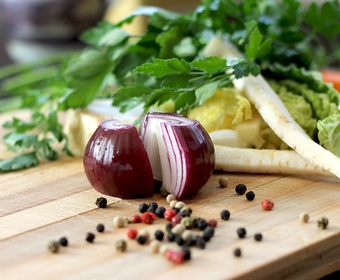Holy vegetable trinities
All regional kitchens have basic techniques and flavors that reappear in a wide range of dishes. Often – if not always – these “holy trinities” consist of finely chopped vegetables that form a taste platform for everything else that goes into the stew, the sauce, salad or whatever is being prepared.
The combined vegetables are seldom the stars of the dish – but they are indispensable for the tasty, satisfying, balanced final result. Here are some of the most well known and most common in professional kitchens:
French mirepoix
”Meerpoá” is a French mix of greesn that form the base for many sauces, soups and casseroles. Traditionally it consists of 2 parts chopped onion, 1 part chopped carrots, and 1 part chopped celery (if the original recipe contains the root or the stems is a matter of discussion).
Mirepoix forms the spine of a French broth.
Italian soffritto
The Italian name given to the same basic vegetable mix is both "battuto" and "soffritto". The chopped vegetables are known as battuto when raw and turn into soffritto when cooked. Soffritto is an indispensable ingredient in, for example, a genuine ragu/Bolognese.
To complicate things further, Spain also has its own holy trinity which goes by the same name, but contains other ingredients:
Spanish sofrito
Spains version of sofrito consists of chopped onions, chopped tomatoes, and chopped garlic. In Portugal the same trinity is known as “refogado”. It can also – depending on which chef you ask – contain chopped parsley. According to some, even peppers belong in a sofrito.
There are medieval records of this recipe. This causes problems since there were neither tomatoes nor peppers available in the old world in those days. In other words, the contents in a sofrito can vary quite a lot from one kitchen to another…
Many South American countries have developed their own, spicier versions of sofrito with – for example – chili and/or cumin.
Portugals refogado
Portugal and Brasil share the same basic mixture with onions, garlic and tomato and call it refogado. According to many – but not all – Portuguese recipes, the onions should be braised.
German suppengrün
Germanys own vegetable trinity consists of chopped leeks, chopped carrots and chopped celery. The name, which translates as “soup greens”, says it all.
Polish wloszczyzna
Polands and Bohemias equivalent to suppengrün – with the tongue twister name – also contains chopped parsley root. It may also contain kale/cabbage in some form.
Creole holy trinity
The USA:s own vegetable mix – not least in New Orleans and thereabouts – consists of chopped onions, chopped celery and chopped peppers. In case your dinner guests bring up the question:
The name ”creole” refers to (multiple) origins, as in the ethnic groups that gave birth to the spicy, exciting New Orleans cuisine. (If you want to impress them some more you can tell them that it is related to the word ”crianza” that has to do with the origins of your bottle of Rioja...)
No gumbo without holy trinity.
South Asian masala
For most westerners masala is synonymous with a dry spice mix (not least of the “garam” sort, meaning hot/spicy). But at home in India, Pakistan and Bangladesh this is a mix created from fresh ingredients. The basic version contains garlic, onions, tomato, ginger and turmeric. And then you can add chili, cumin, cinnamon, coriander, and more.
Not a trinity, but certainly an indispensable base for the South Asian cuisine.



